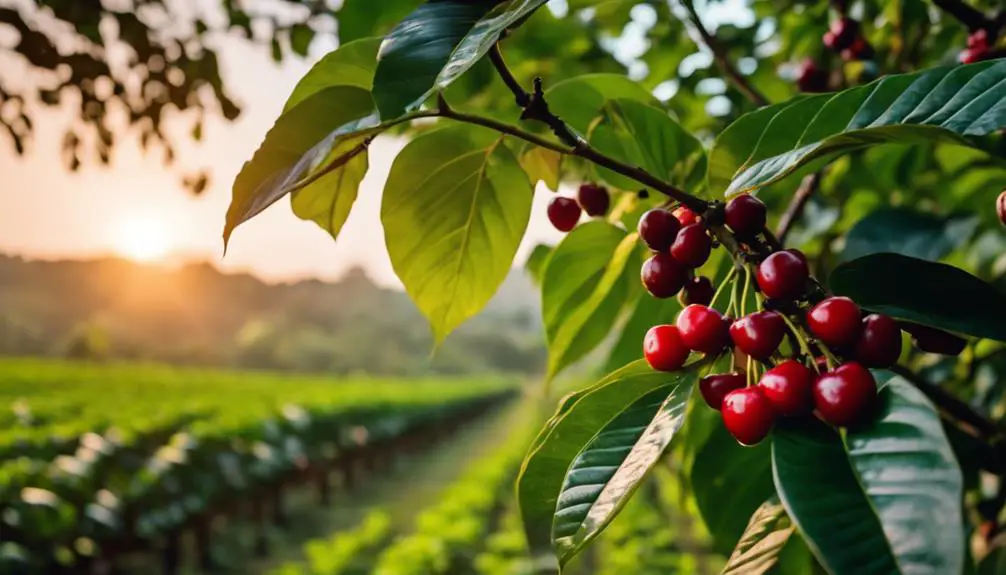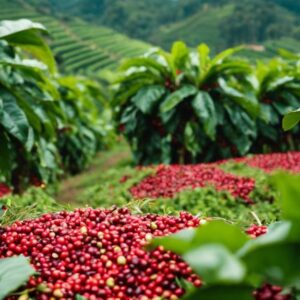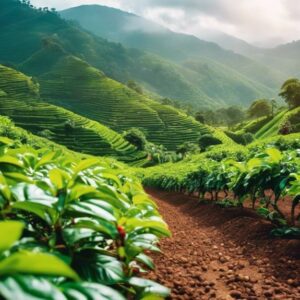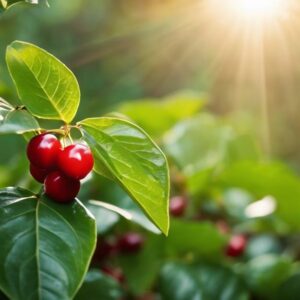Have you ever wondered what sets Arabica coffee apart from the rest?
The distinct characteristics of Arabica coffee beans go beyond just taste.
Understanding the intricate details of Arabica’s profile can lead you to appreciate the complexities behind this beloved brew.
The next time you take a sip of your favorite cup of coffee, consider the journey these beans have taken to your mug.
The Botanical Characteristics of Arabica Coffee

To understand the Arabica plant fully, you must consider its botanical characteristics. This includes exploring the growth conditions required for Arabica to thrive.
Discovering the ideal environment for Arabica cultivation is key to appreciating its unique traits and flavors.
Understanding the Arabica Plant
When examining the Arabica plant, you’ll notice its unique anatomy and features that set it apart from other coffee varieties, like Robusta. Understanding these botanical characteristics is crucial for appreciating the nuances in Arabica coffee.
Let’s explore the distinctions between Arabica and Robusta to grasp the essence of this beloved coffee plant.
Anatomy of the Arabica Coffee Plant
Understanding the anatomy of the Arabica coffee plant provides valuable insights into the botanical characteristics of this prized species. Here are three key aspects to consider:
- Leaf Structure: Arabica plants have distinct elongated leaves with prominent veins.
- Root System: Their root systems are shallow but extensive, aiding in nutrient absorption.
- Flower Formation: Arabica plants produce delicate white flowers before developing coffee cherries.
Arabica vs. Robusta: Distinguishing Features
Delving into the botanical characteristics of Arabica coffee plants reveals distinct features that set them apart from Robusta coffee plants. Arabica coffee is known for its superior flavor, acidity, and aroma compared to Robusta. This difference stems from the genetics of the plants, ultimately impacting the quality of the coffee beans produced.
Understanding these distinctions can lead to a deeper appreciation for the nuances in coffee flavors.
| Features | Arabica Coffee | Robusta Coffee |
|---|---|---|
| Flavor | Superior and more nuanced | Bitter and less complex |
| Acidity | Bright and vibrant | Less pronounced |
| Aroma | Floral and aromatic | Earthy and woody |
| Genetics | More delicate and complex | Hardy and resilient |
Growth Conditions: The Ideal Environment for Arabica
When growing Arabica coffee, altitude and climate play critical roles in shaping the beans’ flavors.
The higher the altitude, the more complex and nuanced the taste of the coffee.
Additionally, the right combination of climate and soil is essential for cultivating the perfect Arabica bean.
The Role of Altitude in Flavor Development
Altitude plays a crucial role in shaping the distinct flavors of Arabica coffee beans.
- Higher altitudes lead to slower bean maturation, intensifying flavor profiles.
- Beans grown at specific altitudes develop unique acidity levels.
- Altitude affects the bean’s sugar content, influencing the overall taste experience.
Climate and Soil: Crafting the Perfect Arabica Bean
Crafting the perfect Arabica bean relies heavily on understanding how climate and soil conditions interact to shape the distinctive qualities of these sought-after coffee beans.
- Climate Consistency: Ensuring a stable climate year-round is crucial for Arabica’s delicate nature.
- Soil Nutrients: The right balance of nutrients in the soil enhances the flavor profile of Arabica beans.
- Crafting Perfection: Skillfully blending climate and soil conditions is key to cultivating the perfect Arabica bean.
The Chemistry of Taste: Arabica’s Flavor Profile

As you explore Arabica coffee’s flavor profile, you’ll uncover the intricate chemistry behind its taste.
The physical and chemical composition of the beans play a crucial role in determining the final flavor.
Additionally, the processing methods employed further shape the unique characteristics that define Arabica coffee’s taste.
Bean Characteristics: The Physical and Chemical Composition
Let’s explore Arabica’s complex flavor notes and how the caffeine content impacts both health and taste.
Arabica’s flavor profile is a result of its unique physical and chemical composition, contributing to its renowned taste.
Understanding the chemistry behind Arabica’s flavors can deepen your appreciation for this beloved coffee variety.
Exploring Arabica’s Complex Flavor Notes
Exploring Arabica’s complex flavor notes reveals a fascinating interplay of physical and chemical characteristics that contribute to its unique taste profile.
- Aromatics Fusion: Arabica’s flavor notes blend floral, fruity, and acidic tones in a harmonious symphony.
- Acidity Dynamics: The complex acidity in Arabica creates a bright, vibrant sensation on your palate.
- Sweetness Balance: Arabica strikes a perfect equilibrium between natural sweetness and subtle bitterness, enhancing its overall complexity.
The Impact of Caffeine Content on Health and Taste
Discover how the caffeine content in Arabica coffee influences both its health benefits and taste profile, shedding light on the intricate relationship between chemistry and flavor.
The caffeine content impacts the taste by providing a bitter note, but it also contributes to the stimulating effects that many coffee drinkers seek. Moderation is key to reaping the health benefits without overdoing the caffeine intake.
| Caffeine Content | Health Impact | Taste Profile |
|---|---|---|
| Modulates alertness | Antioxidant properties | Adds bitterness |
| Enhances focus | Supports metabolism | Provides a stimulating kick |
| Influences mood | Improves physical performance | Contributes to complexity |
The Role of Processing in Flavor
When it comes to Arabica coffee, the processing method plays a crucial role in determining its flavor profile.
From the initial cherry to the final cup, each step in the processing chain can impact the taste of the coffee beans.
Understanding the differences between wet and dry processing is essential in appreciating the nuances of Arabica’s complex flavors.
From Cherry to Cup: The Transformation of Arabica Beans
The journey of Arabica beans from cherry to cup involves a meticulous process that significantly influences the flavor profile experienced by coffee enthusiasts.
1) Innovative harvesting techniques elevate the quality of the beans.
2) Precise roasting methods unlock unique flavor notes.
3) The origins of the beans play a crucial role in defining their distinct qualities.
Wet vs. Dry Processing: Influences on Arabica’s Taste
Exploring the processing methods, such as wet and dry processing, is essential to understanding how Arabica’s taste is influenced, shaping its distinct flavor profile. Wet processing involves removing the cherry’s skin before drying, resulting in a cleaner taste.
On the other hand, dry processing allows the bean to ferment in the cherry, imparting fruity notes. The choice of processing significantly influences Arabica’s final taste.
| Wet Processing | Dry Processing |
|---|---|
| Clean taste | Fruity notes |
Cultivation and Harvesting: The Art and Science

When it comes to cultivating and harvesting Arabica coffee, you’ll find a blend of tradition and innovation in farming practices.
Discovering the path to sustainability in Arabica production involves a delicate balance of art and science.
Farming Practices: Tradition Meets Innovation
When growing Arabica coffee, you face challenges like pests and diseases. Harvesting techniques play a crucial role in determining the quality of the coffee. Let’s explore how these aspects merge tradition with innovation in the cultivation and harvesting processes.
- Traditional methods rooted in generations of expertise
- Innovative approaches incorporating technology and research
- Balancing artistry with scientific precision
The Challenge of Growing Arabica: Pests and Diseases
Navigating the intricacies of cultivating Arabica coffee involves combating a myriad of pests and diseases that threaten the crop’s health and productivity.
- Implement integrated pest management strategies for sustainable control.
- Utilize resistant Arabica coffee varieties to combat specific diseases.
- Explore innovative techniques like biological control to minimize chemical usage and environmental impact.
Harvesting Arabica: Techniques That Make a Difference
Combatting the various pests and diseases in Arabica cultivation is just the beginning; now let’s explore the crucial techniques that can truly make a difference in the harvesting process.
- Selective Picking: Harvesting only ripe cherries ensures optimal flavor.
- Mechanical Stripping: Innovative machines strip cherries efficiently.
- Sun-Drying Methods: Utilizing advanced sun-drying techniques enhances Arabica’s unique characteristics.
The Path to Sustainability in Arabica Production
When it comes to sustainability in Arabica production, you need to consider the impact of organic and fair-trade practices on both quality and community.
Additionally, water use and environmental concerns play a crucial role in the cultivation and harvesting processes.
Organic and Fair-Trade Practices: Impact on Quality and Community
To achieve sustainable Arabica coffee production, implementing organic and fair-trade practices is crucial for enhancing quality and supporting the community. These practices not only have a positive impact on the environment but also ensure that the farmers receive fair compensation for their hard work.
By choosing organic and fair-trade Arabica coffee, you are contributing to the well-being of both the environment and the communities involved.
| Benefits of Organic and Fair-Trade Practices |
|---|
| – Enhanced Quality |
| – Environmental Impact |
| Support for Coffee Farming Communities |
| – Fair Compensation for Farmers |
Water Use and Environmental Concerns
Exploring sustainable practices in water use and addressing environmental concerns are essential components of cultivating and harvesting Arabica coffee, paving the way for a more sustainable future in its production.
- Efficient Water Consumption: Implementing advanced irrigation techniques to optimize water usage.
- Environmental Impact Reduction: Minimizing water pollution and soil degradation through responsible practices.
- Moisture Management: Balancing moisture levels in the soil to enhance coffee plant health and yield.
Roasting and Brewing: Perfecting the Arabica Experience

When roasting Arabica coffee, you can craft a unique flavor profile that suits your taste preferences perfectly.
Brewing excellence is all about mastering techniques that result in the best cup of Arabica coffee you’ve ever had.
Roasting Arabica: Crafting the Flavor Profile
When roasting Arabica coffee beans, you have the power to shape their flavor spectrum by choosing between light, medium, and dark roasts. Understanding the science behind roasting – the precise balance of time and temperature – is crucial in perfecting the flavor profile.
Experimenting with different roast levels allows you to craft the ideal Arabica coffee experience tailored to your preferences.
Light, Medium, and Dark Roasts: A Spectrum of Flavors
Crafting the perfect roast for your Arabica coffee beans involves a delicate balance between light, medium, and dark flavors to create a spectrum of taste experiences.
Explore the diverse characteristics of Arabica through different roasts in the table below, each offering a unique flavor profile. Let your taste buds savor the innovation and complexity that each roast brings to your coffee experience.
| Light Roast | Medium Roast | Dark Roast |
|---|---|---|
| Floral | Balanced | Bold |
| Citrus | Nutty | Chocolate |
| Light Body | Medium Body | Full Body |
| Bright Acidity | Soft Acidity | Low Acidity |
| Complex | Smooth | Rich |
The Science of Roasting: Time and Temperature
To perfect the flavor profile of your Arabica coffee beans, understanding the science of roasting involves precise control of time and temperature. By manipulating these variables, you can unlock a world of rich and complex flavors in your brew.
Check out the table below to see how different roasting times and temperatures can influence the taste of your Arabica coffee.
| Roasting Time | Roasting Temperature |
|---|---|
| Short | High |
| Medium | Medium-High |
| Long | Medium |
| Very Long | Low |
Brewing Excellence: Techniques for the Best Cup
To achieve the best cup of Arabica coffee, you must pay attention to crucial factors like grinding, water quality, and brewing methods.
These elements play a significant role in the final flavor and aroma of your coffee.
Understanding their influence can help you perfect your Arabica brewing experience.
Grinding, Water Quality, and Brewing Methods
For the best cup of Arabica coffee, ensuring the proper grinding, water quality, and brewing methods is essential.
- Grinding: Consistent grind size enhances extraction for a balanced flavor profile.
- Water Quality: Optimal mineral content and temperature affect taste and aroma.
- Brewing Methods: Experiment with pour-over, French press, or AeroPress for unique sensory experiences.
The Influence of Brewing on Flavor and Aroma
Enhancing the flavor and aroma of Arabica coffee hinges greatly on mastering the brewing process, a crucial step in perfecting the overall coffee experience.
- 1. Temperature Control: Experiment with different water temperatures to extract the desired flavors.
- 2. Brewing Time: Adjust the brewing time to enhance or subdue the coffee’s aroma intensity.
- 3. Grind Consistency: Consistent grinding ensures a balanced extraction, influencing the final flavor profile.
Arabica Coffee Varieties: Exploring Diversity

You can start exploring the diverse world of Arabica coffee varieties by understanding the significance of genetic variability and how it influences taste profiles.
Uncover the unique regional specialties that arise from the concept of terroir, where environmental factors contribute to distinct flavors in Arabica beans.
These points will guide you through the fascinating journey of discovering the rich diversity within Arabica coffee.
The Significance of Genetic Variability
As a coffee enthusiast, you must appreciate the rich history behind Arabica coffee varieties. Typica, Bourbon, and other ancestral cultivars lay the foundation for the diverse flavors we enjoy today. Geisha and SL varieties showcase the apex of flavor complexity, highlighting the significance of genetic variability in the world of Arabica coffee.
Deeper Meaning:
- Heritage Roots: Understanding the lineage of Arabica varieties provides insight into the origins of different flavor profiles.
- Flavor Evolution: Geisha and SL varieties represent the pinnacle of taste complexity, showing how genetic variability can enhance coffee quality.
- Genetic Diversity Impact: Exploring the diverse Arabica gene pool reveals the potential for innovation and discovery in the coffee industry.
Typica, Bourbon, and Beyond: Tracing Arabica’s Lineage
Tracing Arabica’s lineage through varieties like Typica and Bourbon reveals the rich diversity and genetic variability within the world of Arabica coffee.
- Uncovering Origins: Delving into the ancestry of Arabica unveils a tapestry of flavors waiting to be discovered.
- Genetic Exploration: Understanding the lineage of Typica and Bourbon sheds light on the evolution of Arabica’s desirable traits.
- Innovation Potential: Leveraging genetic diversity opens doors to creating new, exceptional Arabica varieties.
Geisha, SL Varieties: The Pinnacle of Flavor Complexity
Exploring the pinnacle of flavor complexity in Arabica coffee varieties, Geisha and SL varieties stand out as remarkable examples of genetic variability shaping exquisite taste profiles. These exceptional varieties redefine the boundaries of flavor complexity in the coffee world, captivating enthusiasts with their unique characteristics.
Embodying innovation and sophistication, they elevate the Arabica coffee experience to new heights, setting a standard for premium quality and unparalleled taste.
- Innovative Genetic Variability: Geisha and SL varieties showcase cutting-edge genetic diversity.
- Unparalleled Flavor Complexity: Arabica’s traits reach new heights with Geisha and SL varieties.
- Premium Quality Standard: Geisha and SL varieties set the bar for exquisite taste profiles.
Regional Specialties: Terroir and Taste
You should take a moment to appreciate the rich tapestry of Arabica coffee flavors that are intricately linked to their specific regions like Ethiopia, Kenya, Colombia, and Brazil.
Each of these countries offers a unique terroir that influences the taste profiles of the Arabica beans cultivated there, providing coffee enthusiasts with a diverse range of flavor experiences to explore.
Understanding the regional specialties behind Arabica coffee can deepen your appreciation for the intricate relationship between terroir and taste in the world of specialty coffee.
Ethiopia, Kenya, Colombia, Brazil: Unraveling Arabica’s Homeland
Unraveling the origins of Arabica coffee leads us on a flavorful journey through the diverse landscapes of Ethiopia, Kenya, Colombia, and Brazil.
- 1. Ethiopia**: Birthplace of Arabica, offering delicate floral and citrus notes.
- 2. Kenya: Known for its bright acidity and fruity flavors.
- 3. Colombia**: Produces balanced coffees with caramel sweetness.
Conclusion
Now that you’ve learned about the botanical characteristics, flavor profile, cultivation, and brewing of Arabica coffee, imagine waking up to the rich aroma of freshly roasted beans, the smooth taste of a perfectly brewed cup, and the satisfaction of knowing you’re enjoying one of the world’s most beloved coffees.
Embrace the diversity of Arabica varieties and savor each sip as you embark on a flavorful journey through the world of coffee.
Cheers to the perfect cup!























